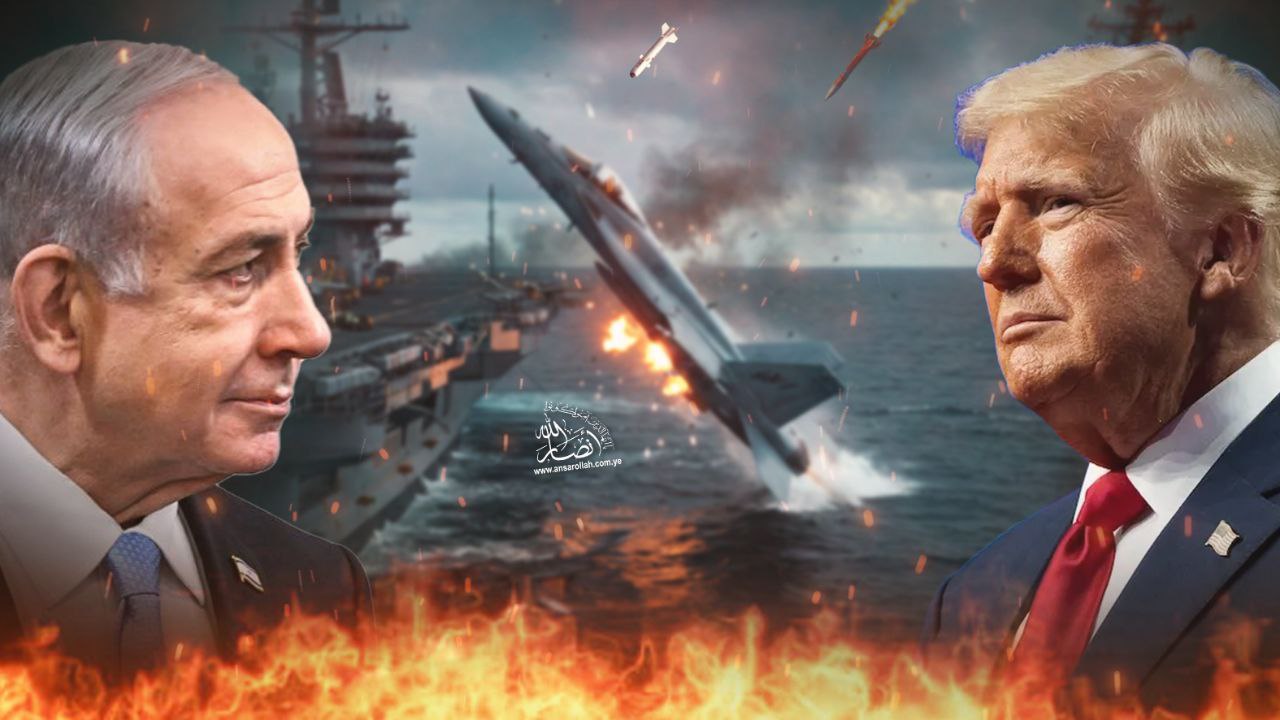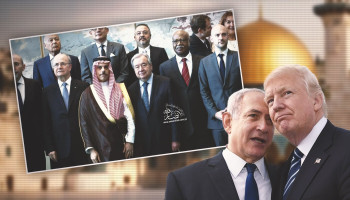The American President Trump's personal announcement of the ceasefire agreement reached in Muscat carries within it an implicit acknowledgment of failure. This comes in stark contrast to his earlier declarations centered on “eradication” and “elimination,” which conveyed expectations of a decisive military victory. Many analyses and commentaries have interpreted Trump’s announcement as a clear defeat in the confrontation with Yemen, and, by extension, a setback for the so-called “Prosperity Alliance” — an alliance based on aggressive foundations aimed at securing U.S.-Israeli commercial interests through force.
The announcement was driven, in part, by Trump’s desire to visit the region and appear as a figure capable of exerting both military and diplomatic influence. As with his previous engagements — negotiations with the Taliban, the meeting with North Korea’s leader during his first term, dialogue with Moscow over Ukraine, and attempts to engage with Iran — Trump’s behavior remains unpredictable.
The recent agreement between the United States and Sana’a, which stipulates a mutual ceasefire in the Red Sea, triggered angry and apprehensive reactions within the Zionist entity. The accord was not viewed merely as a bilateral security arrangement, but rather as a signal of deeper shifts in American foreign policy — shifts that touch the core of the strategic relationship between Washington and the Israeli occupation.
A Strategic Transformation
The implications of the U.S.-Yemen ceasefire agreement are far from superficial. They reaffirm the decline of the imperial unipolar order and highlight the ability of oppressed nations to reclaim their right to sovereignty, dignity, and development.
The agreement reflects a strategic transformation that can be read as one manifestation of the profound crisis facing America as a former global hegemon. Where it was once capable of imposing comprehensive deterrence formulas, it now finds itself negotiating with a peripheral actor, not a central global power, on the basis of conditional parity.
That Washington is now negotiating with Sana’a — rather than bombing or isolating it, as had been the policy since the 2015 aggression — means that the U.S., whether willingly or not, now treats Sana’a as a capable actor with deterrent power and the ability to impose costs. It no longer views Sana’a as a marginal force or merely a “coup group.” This corresponds with the broader reality that the ability to impose rules of engagement is a sign of a fundamental shift in global power dynamics.
The American failure in Yemen reveals a significant strategic transformation on both regional and international levels. The agreement with Sana’a not only ended a chapter of military escalation but also served as tangible proof of the collapse of the U.S.-Israeli deterrence doctrine, especially after the targeting of Lod Airport (Ben Gurion) deep inside Israeli-occupied territory. This clearly demonstrated the ineffectiveness of traditional deterrence strategies and confirmed that resistance forces are now capable of striking the core of the Western alliance without facing decisive military retaliation.
Overall, the U.S.-Yemen ceasefire in the Red Sea is not a partial settlement but a strategic admission that the era of uncontested American dominance is effectively over. The United States is moving from a phase of hegemonic assertiveness to one of defensive retreat, while actors assert realities from positions of strength and independence, not subordination.
How the Zionists Interpreted the Agreement
A Strategic Shift in U.S. Policy
Zionist political and security elites saw Trump’s decision to halt attacks on Yemen as a concession to Sana’a’s demands, not as the result of any U.S. battlefield success. To them, it marked a violation of the “Israel First” principle that had shaped much of Washington’s foreign policy in recent years. Instead, it aligned with the “America First” slogan, which has frequently come at the expense of allies, including NATO. The U.S. decision to engage in negotiations with Russia over Ukraine, for example, shocked European nations who realized that “America First” was not about balancing U.S. and allied interests, but often about disregarding those of its partners altogether.
The ceasefire agreement sidelined “Israel” entirely; its interests were not included in the terms. This exclusion was interpreted as a deliberate snub, sparking shock within the Zionist establishment. Key sites within the occupied territories were left exposed to potential Yemeni military action without American protection — a development interpreted as the beginning of a new American policy framework driven by immediate self-interest rather than historic commitments.
Given the Zionist narrative that views Sana’a as closely aligned with Tehran, Washington’s willingness to engage with Sana’a without preconditions was seen as a possible prelude to a broader thaw in U.S.-Iranian relations. Such a development would directly threaten the Zionist doctrine of aggressive deterrence, which relies on unwavering American support in confronting Iran’s nuclear program.
The agreement constituted an implicit recognition by Washington of the failure of its military approach in the Red Sea. Despite overwhelming technological and military superiority, America was unable to prevent Sana’a’s attacks — a reality that exposed the limits of American power and weakened Israeli faith in the strategic partnership as a security guarantee. This, in turn, is pushing “Israel” toward greater self-reliance — a dynamic also playing out in Europe, as reflected in French President Macron’s call for European strategic autonomy.
Within Zionist discourse, the breakdown of the Trump-Netanyahu alliance has led to an unprecedented decline in coordination. Amid mutual accusations of manipulation and failure, the agreement with Sana’a was seen by “Israel” as the culmination of this political fracture. Washington is now treating “Israel” as a secondary player in critical issues such as normalization with Saudi Arabia and the conclusion of the war in Gaza.
The Zionists' Options After the Agreement
The Israeli entity has declared that it is not bound by the agreement and will continue to target Yemen — even escalating its strikes to include infrastructure, launch platforms, and Yemeni ports. This aggressive strategy appears aimed at restoring lost deterrence and compensating for the vulnerability exposed by the absence of an American security umbrella — a weakness now apparent in the face of the resistance axis and normalization regimes alike.
In the context of the Zionist narrative linking Sana’a to Tehran, the entity has even hinted at the possibility of expanding the conflict into Iran’s interior. This threat may be intended to pressure Washington into avoiding any rapprochement with Iran, but it also risks broadening the scope of regional confrontation.
Despite the fact that Yemeni missiles have struck sensitive targets such as Lod Airport (Ben Gurion), Zionist domestic rhetoric continues to promote a narrative of full control, based on the supposed effectiveness of its air defense systems. This discourse serves to minimize the perceived Yemeni threat and protect the psychological stability of the “interior front.” Israeli messaging balances between reassuring its domestic audience by citing statistics and the supposedly limited impact of Yemeni attacks, and projecting strong retaliatory threats to external actors. This dual messaging reflects both a political and security dilemma, as the Zionist leadership struggles to manage a crisis of confidence without openly admitting strategic impotence.
A Critique of the Zionist Perspective
Overall, the Zionists’ reaction to the U.S.-Yemen ceasefire agreement reveals the extent of its anxiety over ongoing shifts in American foreign policy, which has begun to move away from its doctrine of unconditional support for the Israeli entity toward a more pragmatic, interest-driven approach.
In response, “Israel” is seeking to compensate for declining American involvement through unilateral escalation and attempts to impose new power dynamics through force. However, this approach may ignite a new front without any guarantee of a decisive outcome.
In conclusion, “Israel” no longer appears to be the sole actor dictating the terms of regional engagement. It now faces a new geopolitical trajectory that has rendered its position increasingly fragile.
While the Zionist entity often exaggerates the extent of deterioration in its strategic relationship with the United States, it would be inaccurate to speak of an American abandonment. Rather, what has occurred is Washington’s refusal to fight directly on Israel’s behalf in the context of the Red Sea confrontation — a front closely tied to the ongoing genocidal war in Gaza. Strategic military support and intelligence cooperation will nevertheless continue, both in the face of Yemen and the broader resistance axis.
Indeed, it remains in the core interest of the United States — and the broader West — to maintain the Zionist entity as the region’s dominant force, in order to weaken Arab and Islamic states and to support the foundations of a new colonial project.











